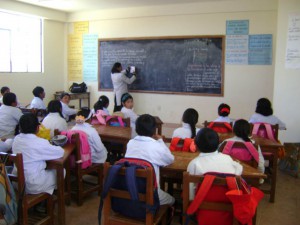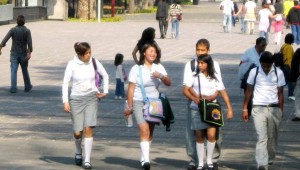Por: Teresa Ortuño
Si todas las mujeres tuvieran acceso a educación primaria se reduciría en un sexto el número de matrimonios infantiles y la mortalidad de este sector.
Se evitarían dos tercios de las muertes maternas y también podrían prevenirse siete millones de casos de VIH/SIDA en la próxima década si cada niño recibiera educación.
Cada año más de escolarización puede aumentar los ingresos de un individuo en un 10 por ciento. Si todos los niños disfrutaran de igualdad en el acceso a la educación, el ingreso per cápita podría aumentar.
Los beneficios económicos de la educación primaria universal superarían con creces el aumento en el gasto público necesario para lograrlo.
En México, mucho se ha avanzado. En el año 2000, sólo el 32.8 por ciento de los jóvenes entre 15 y 24 años iba a la escuela. En 2015, con una población mayor, el 44 por ciento de ellos acude a estudiar. Sí, estupendo. Pero aún nos falta el 66 por ciento en Educación Media Superior y Superior.
En el mundo, hay 57 millones de infantes que no acuden a la Primaria. 57 millones de vidas, de personas que difícilmente romperán el círculo de la pobreza. A ellos hay que añadir otros 69 millones que no van a Secundaria.
Es por ello que la UNESCO lanza una campaña para que, en todo el mundo, durante la última semana de abril, se forme conciencia acerca de la importancia de destinar financiamiento a la Educación para cerrar estas brechas.
La Semana de Acción Mundial por la Educación (SAME) es una semana de movilización ciudadana, fundamentalmente de niños, niñas y jóvenes, que pretende acercar las reivindicaciones de la Campaña a la sociedad en general y a los responsables políticos de cada país, y llamar su atención sobre la necesidad de hacer real el derecho a una educación básica de calidad.
 México es un país que gasta en Educación el porcentaje recomendado. Pero no gasta del todo bien. La Reforma Constitucional de 2011, que establece la obligación del Estado de brindar Educación Media Superior a todo el que la solicite, requiere, obviamente, que el alumno haya terminado la Secundaria. Se estableció un artículo transitorio en esa Reforma, a fin de que para 2021 (diez años después de emitida), las autoridades mexicanas pudieran estar en condiciones de brindar un espacio a todos los jóvenes.
México es un país que gasta en Educación el porcentaje recomendado. Pero no gasta del todo bien. La Reforma Constitucional de 2011, que establece la obligación del Estado de brindar Educación Media Superior a todo el que la solicite, requiere, obviamente, que el alumno haya terminado la Secundaria. Se estableció un artículo transitorio en esa Reforma, a fin de que para 2021 (diez años después de emitida), las autoridades mexicanas pudieran estar en condiciones de brindar un espacio a todos los jóvenes.
Sin embargo, no parece que esa expectativa vaya a poderse cumplir cabalmente.
Para ello es que sirven estas campañas, para acentuar la insistencia no sólo en destinar los recursos financieros necesarios, sino para gastarlos bien. Que no se desperdicien.
La Semana de Acción Mundial por la Educación es un momento en que las Organizaciones de Sociedad Civil, como SUMA POR LA EDUCACIÓN, pueden alzar la voz para formar conciencia en el Poder Legislativo y Ejecutivo, así como en los tres órdenes de Gobierno, para analizar y proponer el Gasto Educativo como vía de acceso a una mejor calidad de vida para nuestros jóvenes.
Los gobernantes saben que no alcanza para todo, deben tomar decisiones y priorizar. Sin embargo, no basta el monto. Se ha señalado el desperdicio, y en ocasiones el despilfarro, en algunas partidas. Eso también forma parte de la agenda de exigencias ciudadanas al hablar de destinar mayores fondos a la educación.



 México es un país que gasta en Educación el porcentaje recomendado. Pero no gasta del todo bien. La Reforma Constitucional de 2011, que establece la obligación del Estado de brindar Educación Media Superior a todo el que la solicite, requiere, obviamente, que el alumno haya terminado la Secundaria. Se estableció un artículo transitorio en esa Reforma, a fin de que para 2021 (diez años después de emitida), las autoridades mexicanas pudieran estar en condiciones de brindar un espacio a todos los jóvenes.
México es un país que gasta en Educación el porcentaje recomendado. Pero no gasta del todo bien. La Reforma Constitucional de 2011, que establece la obligación del Estado de brindar Educación Media Superior a todo el que la solicite, requiere, obviamente, que el alumno haya terminado la Secundaria. Se estableció un artículo transitorio en esa Reforma, a fin de que para 2021 (diez años después de emitida), las autoridades mexicanas pudieran estar en condiciones de brindar un espacio a todos los jóvenes.






 Users Today : 38
Users Today : 38 Total Users : 35460247
Total Users : 35460247 Views Today : 47
Views Today : 47 Total views : 3418942
Total views : 3418942